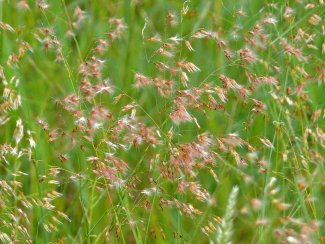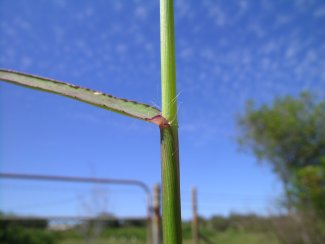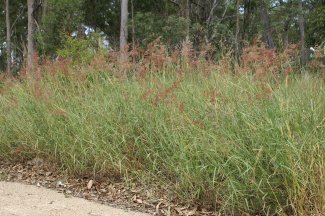Africa East Tropical Africa: Kenya; Tanzania; Uganda Macaronesia: Cape Verde; Spain - Canary Islands Northeast Tropical Africa: Chad; Ethiopia; Somalia; Sudan Northern Africa: Morocco South Tropical Africa: Angola; Malawi; Mozambique; Zambia; Zimbabwe Southern Africa: Botswana; Lesotho; Namibia; South Africa - Transvaal; Swaziland West Tropical Africa: Benin; Burkina Faso; Cote D'Ivoire; Ghana; Niger; Nigeria; Sierra Leone; Togo West-Central Tropical Africa: Burundi; Cameroon; Central African Republic; Rwanda; Sao Tome and Principe; Zaire Western Indian Ocean: Seychelles Asia-Temperate Arabian Peninsula: Oman; Saudi Arabia; Yemen Asia-Tropical Indian Subcontinent: India
Natal grass (Melinis repens) is an erect grass to 28 in tall that has attractive long reddish or pink silky hairs on the triangular fruit at maturity, fading to silvery white with age. It is an annual species that sometimes perennates in warmer climates (Hafliger and Scholz 1980; Haselwood and Motter 1966; Kleinschmidt and Johnson 1977). In California, Natal grass is almost entirely perennial. Its branched inflorescences are open (2-3 in wide) and fluffy. The leaves are narrow and flat (3-8 in long) from unbranched stems. It can flower throughout the year under favorable temperature and moisture conditions but is limited by hard freezes.
Natal grass has naturalized across the southern United States and Pacific Islands and is considered invasive in Florida. Where it is invasive, it often forms large stands that compete with and potentially displace native species. Stands of natal grass are carry fire, further impacting native vegetation. It is native to Africa and eastward to India.
It has a distinctive red colored flower head which makes it attractive as an ornamental grass.
Natal grass is sometimes grown as an ornamental and was reportedly grown for this purpose in the United States as early as 1866 (Tracy 1916). Tracy (1916) also states that natal grass was grown as a forage plant in the U.S. Department of Agriculture (USDA) trial gardens in 1878. Between 1891 and1894, the USDA received natal grass seeds from Natal, South Africa; Queensland, Australia; India; and Hawaii. In 1892,natalgrass was the first forage grass cultivar released by the Florida Agricultural Experiment Station (Mislevy and Quesenberry1999). More than 12,141 ha of cultivated natal grass were reported in central Florida in 1915. Natal grass was often grown between rows of citrus trees (Tracy 1916), which may explain the species’ current prevalence in citrus groves. Natal grass no longer appears to be sold as an ornamental, though a close relative to it, Melinis nerviglumis, is. M. nerviglumis is fairly common in horticulture and very similar in general appearance, but is not invasive.


